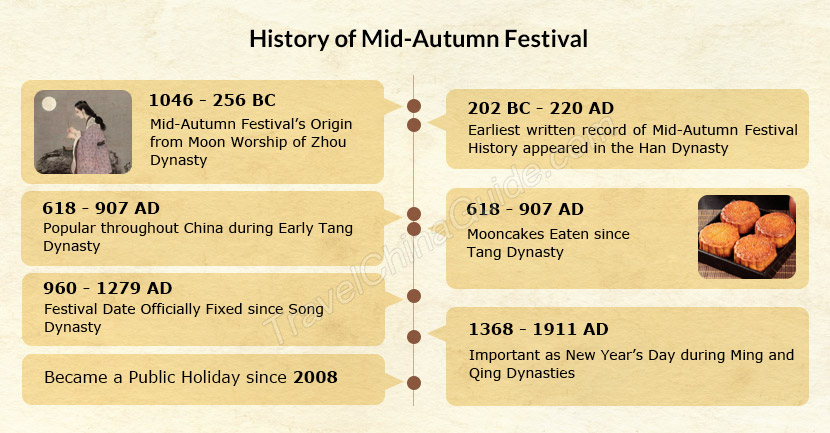Mid-Autumn Festival History and Origin since 3,000 Years Ago
Since early years of Tang Dynasty (618 - 907 AD), various celebrations related to moon became more and more popular, and Mid-Autumn Festival was officially established in Northern Song Dynasty (960 - 1127 AD). By the time of Ming and Qing Dynasties (1368 - 1911 AD), it has become one of the major festivals as important as Chinese New Year. Nowadays, Mid-Autumn Festival is the grandest festival in China second only to Chinese New Year.
 |
Mid-Autumn Festival’s Origin from Moon Worship of Zhou Dynasty (1046 - 256 BC)
There has been a royal ritual system of worshipping the sun in spring and worshipping the moon in autumn in Zhou Dynasty. The moon worship ceremony in the middle of the autumn was to celebrate the harvest, and at the time the full moon, which gradually evolved into the Mid-Autumn Festival over time.
Earliest written record of Mid-Autumn Festival History appeared in the Han Dynasty (202 BC - 220 AD)
When is the first Mid-Autumn Festival? The word “Mid-Autumn” was first seen in the “Book of Rites” written in Han Dynasty (202 BC - 220 AD). It said the crops were mature and harvested during the time of Mid-Autumn to make porridge. At that time, the festival was more like a day to celebrate harvest and the festival food was porridge, not mooncake.
Popular throughout China during Early Tang Dynasty (618 - 907 AD)
Early Tang is an important time in Mid-Autumn Festival history. The second emperor of Tang Dynasty, Li Shimin, inherited the tradition of worshipping the moon on Mid-Autumn Festival. Later two new festivals were set closely, and there were three festivals in one month, which wasted manpower and money when the economy had begun to decline when his son was in the crown. Therefore, the three festivals were merged into one Mid-Autumn Festival, and people had fun together to celebrate the day. Since then, Mid-Autumn Festival became a festival that people widely loved and recognized.
Mooncakes Eaten since Tang Dynasty (618 - 907 AD)
It is said in the early years of Tang Dynasty, the general Li Jing defeated the Turks. At the time of the triumph on the 15th day of the 8th lunar month, Tubo, the Tibetan regime in ancient China, took the opportunity to congratulate the emperor Li Shimin by sending the Hu cakes. Since then, the tradition of eating Hu cakes on that day was formed. The name “mooncake” was later given by the Concubine Yang Yuhuan of a successive emperor Li Longji.
![]() See also 3,000 Years’ Timeline of Mooncake History, from its Origin 'Taishi Cake'
See also 3,000 Years’ Timeline of Mooncake History, from its Origin 'Taishi Cake'
Festival Date Officially Fixed since Song Dynasty (960 - 1279 AD)
In the Song Dynasty, the festival was officially named as Mid-Autumn Festival, and the date was fixed on the 15th day of 8th lunar month, which is a milestone in Mid-Autumn Festival history.
Important as New Year’s Day during Ming and Qing Dynasties (1368 - 1911 AD)
In the Mid-Autumn Festival history, a new custom came into being in Ming Dynasty (1368 - 1644 AD). The daughter who got married would visit her parents on that day, just like they did on the second day of Chinese New Year. By Qing Dynasty (1644 - 1911 AD), Mid-Autumn Festival had become one of the main festivals in China alongside New Year’s Day, on which every family would worship the moon with various sacrifices to celebrate it.
Became a Public Holiday since 2008
Since the 20th century, Mid-Autumn Festival has been an important traditional festival for family reunion in China. On May 20, 2006, Mid-Autumn Festival was included in the first batch of national intangible cultural heritages. However, it was not until 2008 that Mid-Autumn Festival was listed as a holiday.
There is a one-day holiday for Mid-Autumn Festival. But when the festival day is not on Wednesday, Chinese will merge it with the weekend to have three days off. At this time, a travel peak appears leading to crowd scenic spots, congested roads and difficulties in booking train tickets. In some years, Mid-Autumn Festival and Chinese National Day is close enough to form an 8-day holiday, when the travel pressure is much greater.![]() Further Reading
Further Reading
6 Most Well-Known Legends about Mid-Autumn Festival
Mid-Autumn Festival Story - Chang E Flying to the Moon